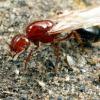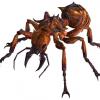After the last rainstorm we had here in southern California, I noticed some ant colonies moving dirt around on the surface. I assumed they were doing so to aerate their nest. Anyway, I took a scoop of the dirt on top and found a whole bunch of winged alates! Is this a common occurrence? I was under the assumption that this time of year was too cold for nuptial flights.
- Formiculture.com
- Forums
- Gallery
- Members
- Member Map
- Chat





















